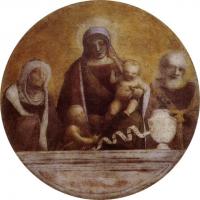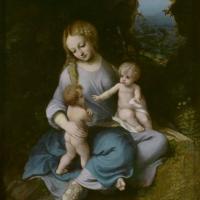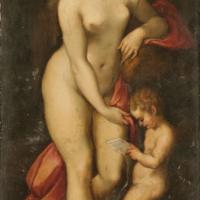Antonio Da Correggio
Venus And Cupid.
$480.00
Antonio Da Correggio
Antonio Da Correggio (1489-1534)
Antonio Allegri da Correggio (August 1489 – March 5, 1534), usually known as Correggio was the foremost painter of the Parma school of the High Italian Renaissance, who was responsible for some of the most vigorous and sensuous works of the 16th century. In his use of dynamic composition, illusionistic perspective and dramatic foreshortening, Correggio prefigured the Baroque art of the 17th century and the Rococo art of the 18th century. He is considered a master of chiaroscuro.
Antonio Allegri was born in Correggio, Italy, a small town near Reggio Emilia. His date of birth is uncertain (around 1489). His father was a merchant. Otherwise little is known about Correggio's early life or training. It is, however, often assumed that he had his first artistic education from his father's brother, the painter Lorenzo Allegri.
In 1503–1505 he was apprenticed to Francesco Bianchi Ferrara in Modena, where he probably became familiar with the classicism of artists like Lorenzo Costa and Francesco Francia, evidence of which can be found in his first works. After a trip to Mantua in 1506, he returned to Correggio, where he stayed until 1510. To this period is assigned the Adoration of the Child with St. Elizabeth and John, which shows clear influences from Costa and Mantegna. In 1514 he probably finished three tondos for the entrance of the church of Sant'Andrea in Mantua, and then returned to Correggio, where, as an independent and increasingly renowned artist, he signed a contract for the Madonna altarpiece in the local monastery of St. Francis (now in the Dresden Gemäldegalerie).
One of his sons, Pomponio Allegri, became an undistinguished painter. Both father and son occasionally referred to themselves using the Latinized form of the family name, Laeti.
Correggio was remembered by his contemporaries as a shadowy, melancholic and introverted character. An enigmatic and eclectic artist, he appears to have emerged from no major apprenticeship. In addition to the influence of Costa, there are echoes of Mantegna's style in his work, and a response to Leonardo da Vinci, as well. Correggio had little immediate influence in terms of apprenticed successors, but his works are now considered to have been revolutionary and influential on subsequent artists. A half-century after his death Correggio's work was well known to Vasari, who felt that he had not had enough "Roman" exposure to make him a better painter. In the 18th and 19th centuries, his works were often noted in the diaries of foreign visitors to Italy, which led to a reevaluation of his art during the period of Romanticism. The flight of the Madonna in the vault of the cupola of the Cathedral of Parma inspired many scenographical decorations in lay and religious palaces during those centuries.
Correggio's illusionistic experiments, in which imaginary spaces replace the natural reality, seem to prefigure many elements of Mannerist, Baroque and Rococo stylistic approaches. He appears to have fostered artistic grandchildren, for example, Giovannino di Pomponio Allegri (1521–1593). Correggio had no direct disciples outside of Parma, where he was influential on the work of Giovanni Maria Francesco Rondani, Parmigianino, Bernardo Gatti, Francesco Madonnina, and Giorgio Gandini del Grano.






